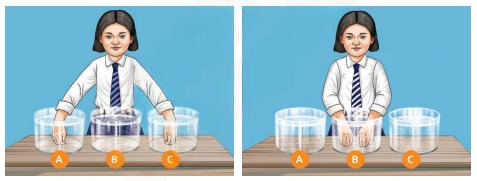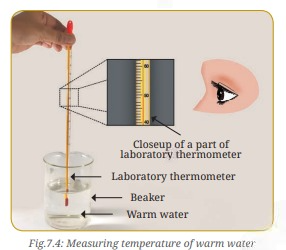Temperature and its Measurement – Complete Guide For Class 6 Science Chapter 7
Welcome to iPrep, your Learning Super App. Our learning resources for the chapter, Temperature and its Measurement in Science for Class 6th are designed to ensure that you grasp this concept with clarity and perfection. Whether studying for an upcoming exam or strengthening your concepts, our engaging animated videos, practice questions and notes offer you the best-integrated learning with interesting explanations and examples.
Objectives Of Learning Temperature and its Measurement
The objectives of learning CBSE Class 6th Science Chapter 7 – Temperature and its Measurement are to help students understand the concept of temperature, how it is measured, and the importance of accurate measurement using various instruments like clinical and laboratory thermometers. By the end of this chapter, students will be able to differentiate between hot and cold objects, understand the use of different temperature scales, and gain practical knowledge through hands-on activities related to measuring temperature in everyday life and scientific experiments.
Introduction to Temperature
According to the chapter Temperature and its Measurement, Temperature plays a key role in our everyday lives, influencing everything from how we feel to the behavior of objects around us. It measures how hot or cold something is, and while we can sometimes estimate temperature by touch, scientific accuracy requires the use of thermometers. This chapter explores different ways of measuring temperature and the instruments we use for this purpose.
Hot or Cold?
As stated in the chapter – Temperature and its Measurement, We often judge how hot or cold something is just by touching it. For instance, the tap water in summer feels warmer than the cool water stored in an earthen pot. But can we always rely on our sense of touch? An investigation helps us understand this better.
Activity: Investigating Hot and Cold
In this activity, we will explore how reliable our sense of touch is when it comes to detecting temperature.
- Materials Needed: Three containers labeled A, B, and C, warm water in A, tap water in B, and ice-cold water in C.
- Steps:
- Dip your right hand in warm water (A) and your left hand in ice-cold water (C) for 1–2 minutes.
- Then place both hands in the tap water (B) and observe what each hand feels.
You’ll notice that your right hand may feel the water in container B as cool, while your left hand may feel it as warm. This shows that our sense of touch can be misleading.

What is Temperature?
Temperature is the scientific measure of how hot or cold something is. A higher temperature means something is hotter, while a lower temperature means it’s cooler. To measure temperature accurately, we use thermometers.
There are two main types of thermometers:
- Clinical thermometers: Used for measuring body temperature.
- Laboratory thermometers: Used for various scientific experiments.
Measuring Temperature
Clinical Thermometer
A clinical thermometer is a device used to measure body temperature. Nowadays, most clinical thermometers are digital and use heat sensors, eliminating the need for mercury, which is toxic.
- How to Use a Clinical Thermometer:
- Wash the tip of the thermometer with soap and water.
- Place the thermometer under the tongue and wait for the beep or light.
- Read the temperature displayed on the digital screen.
The temperature is measured in degrees Celsius (°C). The normal human body temperature is around 37.0 °C, though slight variations are normal.

Precautions while using a thermometer:
- Wash the thermometer before and after use.
- Avoid wetting the digital display.
- Do not hold the thermometer by its tip.
The normal human body temperature is typically considered to be 37.0 °C, but slight variations are common. As mentioned in the chapter Temperature and its Measurement, Factors such as age, time of day, and activity levels influence body temperature. A person’s temperature might be slightly higher or lower than 37.0 °C, as this value is an average based on many healthy individuals. The temperature of human beings usually ranges between 35 °C and 42 °C. For children or elderly individuals, digital thermometers can be used, often showing a temperature of 0.5 °C to 1 °C lower when measured in the armpit.
There are different scales for measuring temperature, such as Celsius (°C), Fahrenheit (°F), and Kelvin (K). On the Fahrenheit scale, the normal body temperature of 37.0 °C is equivalent to 98.6 °F. The Kelvin scale, commonly used in scientific work, is the SI unit of temperature, and the temperature in Kelvin can be found by adding 273.15 to the Celsius temperature.
Temperature scale names, like Celsius, Fahrenheit, and Kelvin, begin with capital letters. However, the word “degree” starts with a lowercase letter, except in the case of Kelvin, where no degree sign is used. When writing temperature, a space is left between the number and the unit, and the plural form “degrees” is used for temperatures above one degree.
These scales are named in honor of the scientists who developed them.
Laboratory Thermometer
Laboratory thermometers are used for scientific experiments. According to the chapter Temperature and its Measurement, they are more sensitive than clinical thermometers and can measure temperatures ranging from –10 °C to 110 °C. These thermometers often contain colored alcohol or mercury.

Activity: Finding the Range of a Laboratory Thermometer
To find the range:
- Observe the thermometer.
- Note the lowest and highest temperatures it can measure.
- The thermometer in the textbook example has a range from –10 °C to 110 °C.
Activity: Calculating the Smallest Value a Thermometer Can Read
Find the smallest temperature difference that can be measured using a laboratory thermometer by:
- Observe the thermometer.
- Counting the number of divisions between the larger marks (e.g., between 0 °C and 10 °C).
- Dividing the temperature difference (10 °C) by the number of smaller divisions (10 divisions).
This tells us that each small division measures 1 °C.
Using a Laboratory Thermometer
As stated in the chapter Temperature and its Measurement – When using a laboratory thermometer, follow these steps:
- Ensure the bulb does not touch the sides or bottom of the container.
- Hold the thermometer vertically.
- Read the temperature while the thermometer is still immersed in the substance being measured.
Activity: Measuring the Temperature of Warm Water
To measure the temperature of warm water:
- Immerse the thermometer in the water and wait until the liquid column stops rising.
- Record the temperature while the thermometer is still in the water, as the reading will drop once it is removed.

Air Temperature
Air temperature is commonly measured using thermometers hung on walls, such as the ones found in classrooms, hospitals, and laboratories. Maximum and minimum air temperatures are recorded in weather reports to track climate changes.
The maximum and minimum temperatures do not stay the same each day, as weather depends on various factors. Typically, temperatures rise as summer approaches and fall during the winter season.
Temperature Scales
There are three main temperature scales:
- Celsius (°C): Used in most scientific studies.
- Fahrenheit (°F): Still in use in some countries like the USA.
- Kelvin (K): The SI unit for temperature, is used in scientific research.
To convert Celsius to Kelvin, use the formula:
Temperature (K) = Temperature (°C) + 273.15
Measuring Extremes of Temperature
As stated in the chapter – Temperature and its Measurement, To measure extreme temperatures, such as boiling water or melting ice, laboratory thermometers are used. It is essential to note that the temperatures of boiling water and melting ice remain constant during these processes.
Activity: Comparing Temperatures
Compare the temperature readings of boiling water recorded by different students in a lab setup:
Name Boiling Water Temp (°C) Phiban 97.8 Shemphang 98.0 Onestar 97.9
The slight differences in readings could result from improper handling of the thermometer.
Let’s Conclude
In conclusion, CBSE Class 6th Science Chapter 7 – Temperature and its Measurement offers a comprehensive understanding of how we measure and interpret temperature in various situations. From investigating how our sense of touch can be misleading, to learning about clinical and laboratory thermometers, this chapter equips students with essential knowledge. By mastering the different methods and instruments used for temperature measurement, learners can enhance their understanding of this critical concept. With iPrep, your Learning Super App, grasping the content of CBSE Class 6th Science Chapter 7 – Temperature and its Measurement becomes an engaging and interactive experience. Dive into the learning resources provided and ensure you’re fully prepared to excel in this chapter!
Practice questions on Chapter 7 - Temperature and its Measurement
Get your free Chapter 7 - Temperature and its Measurement practice quiz of 20+ questions & detailed solutions
Practice Now








